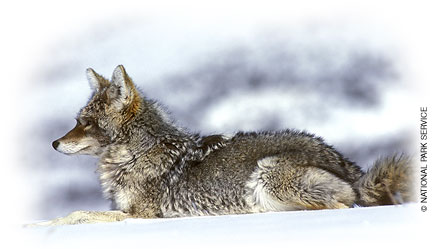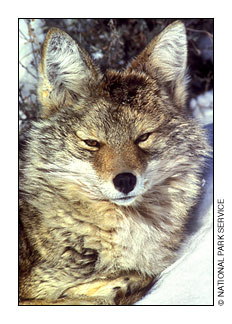Coyote on the ridge
We live in coyote country. If you raise animals, your ears are finely tuned to the yip and yowl of coyote on the move.
Late last night, I heard a pack of voices moving along the ridge across from my house…the sheep, including four newborn lambs, are currently pasturing between the ridge and the house.
I was out of the house in a flash, running toward the pasture to make sure no coyote had finally found a way through the fence. All was well.
I admire coyote and believe farmers need to find ways to share terrain and habitat with them. We invested in and built good fences, but that’s no guarantee against loss. It’s tricky to co-exist with your “enemy.”
So there I was at 1:00 am, standing at the pasture gate listening to the coyote calls move further and further away along the ridge, thinking about co-existence. How many examples could I think of?
Okay, sheep farming in coyote country without shooting or trapping the predators. What else?
I was thinking about this in the context of the recent Congressional dust up. Not very collegial or cooperative. How can we co-exist with people with whom we deeply disagree? Are there good examples from human history? Today?
It’s fundraiser week here at the station. Yes, of course, I want you to contribute some money to the station to help us continue our work. But, here’s the thing: when you think about it, public radio is a great example of conflicting and diverse opinions and ideas co-existing. And, I would argue, that makes for a better community, a better nation, and a better world.
Congress! Listen up! Tune in to your local public radio station. You might learn something…I’ve learned a lot from coyote.










How many members of Congress know the spot on the dial of their local NPR station? How many have ever listened to their local NPR station – for even an hour?
Has anyone ever surveyed this?
Coyotes don’t travel in packs. But they do have so many different vocalizations that a few sound like a mob. We have them down here. They have spread like wildfire. They were almost non-existent in the Adirondacks 30 or 40 years ago. Or there were very few. Now we hear and see them all the time.
Hank, I bet lots of them have and do. I know a few that do. The survey would be interesting.
Ellen why do you have lambs this time of year? Isn’t that a bad idea?
Paul–Around here coyote do sometimes move in loose groups. As for the lambs–a bit of a surprise, a lapse in our management of the rams last spring 🙂 though we have intentionally had lambs at this time to sync with Eastern Orthodox Easter. Most of the lambs will be born winter through spring.
Hank–I agree with Paul. I think quite a few members of Congress follow NPR, on both sides of the aisle. I have no proof, but perhaps this is the contingent that talks across the aisle…;)
Actually, the animals you heard are a good example of co-existing.
What we in the North Country call “coyote” are a hybridized species resulting from inter-breeding among coyote and red wolves that still live as a distinct species in (mostly northern) Ontario. This also accounts for their pack behavior.
Coyote in the American West are pretty small. Adults weigh between 20 and 30 pounds. Our (eastern) coyote can get to 50 to 60 pounds.
Paul, these animals have been seen in northern New York behaving very much like wolf packs. They’re bringing down adult deer (but wouldn’t mind a nice young lamb).
They’re still not donating to NCPR, though I’m not sure the station would want a contribution of a thoroughly gnawed and licked-clean animal carcass.
Ellen, thanks. I hunt here where I live in the Finger Lakes as well as in the Adirondacks. I hear coyotes in both places “talking” to each other in what appears to be groups. But it is interesting, when I see the animals or the tracks, they are usually alone or in pairs.
Jonathan Brown you leave my lambs alone!
Jonathan,
Yes true. I think that the term Eastern Coyote is perfect for this hybrid. If you are familiar with wolves (which it sounds like you are) these are still much more like a coyote than a wolf.
I have researched this quite a bit. There is good evidence that coyotes can and do kill deer that are healthy (as measured by bone marrow). But the idea of them “behaving like wolf packs” can you point me to the research on this? Thanks. I have seen several papers where they have documented two coyotes working together where one chases off a doe watching over fawns so that the other can swoop in and kill the other small deer. But that isn’t really “pack like” behavior by any stretch. I have seen one you tube video of two coyotes killing a mature buck (which you can’t say wasn’t already injured from the footage) but again wasn’t really a “pack”. And that was just one video. Another one titled “two coyotes kill a white tailed deer” is a video of two coyotes “eating” a deer!
I am open to the idea that they could operate like a pack, but I haven’t seen any real evidence to back it up yet. I certainly think that coyotes play a serious role in deer mortality in the Adirondacks. Studies have shown that in some areas fawns are mainly weened on venison.
Ellen, the only interaction I’ve had with lambs was when they were on the wrong side of a menu.
Come to think of it, if you’re trying to engage the coyote demographic, I suggest putting a tajine pot on the station’s list of thank-you gifts.
Careful what you wish for, though. Once the coyotes become dedicated listeners, you’re bound to be flooded with requests for Howlin’ Wolf. (Wouldn’t be so bad, really…)
Paul-
I’ve heard two stories of coyote acting as a pack. One from an amateur naturalist who spends lots of time inside the Blue Line, the other from a hunter who said he was shocked to see these animals behave that way.
I’ve known them long enough to (mostly) trust their stories (within reason), partly because of all the details they were able to describe and because they admit not knowing some details (the first time I ask).
Biologists (and other scientific types) are trying to document coyote behavior. Here are links to news stories about their work:
http://www.scientificamerican.com/blog/post.cfm?id=wylie-coywolf-the-coyote-wolf-hybri-2009-09-23
http://news.nationalgeographic.com/news/2011/11/111107-hybrids-coyotes-wolf-virginia-dna-animals-science/?rptregcta=reg_free_np&rptregcampaign=20131016_rw_membership_n1p_us_se_c1#
http://www.boston.com/news/science/articles/2011/05/31/study_eastern_wolves_are_hybrids_with_coyotes/
Roland Kays figures prominently in these stories. He’s the curator of mammals at the NYS Museum in Albany. I’d shoot him an e-mail if you want to probe further.
And it’s important to remain skeptical about all this. But the behavior issue (bringing down deer, especially as a pack) is really important. Because, if true, then a pack of eastern coyote could be a threat to people in the Adk backcountry. And that would be new.
(I think I need to say this, too, for clarity’s sake: there is NO documented evidence that eastern coyote are a threat to people. I don’t think any of the big mammals who live here are, unless desperate hunger, rabies or really stupid people are involved. To wit: don’t take a peanut butter bath before venturing into the wilds, don’t play “here kitty kitty” with a mountain lion (if you actually see one outside a zoo) and don’t try to take a selfie with your arm around a moose. That oughta’ cover it, right?)